Valuation of Personal Property and Fixtures – Lesson 5 – Determining the Economic Life/Average Service Life of Equipment and Fixtures
Appraisal Training: Self-Paced Online Learning Session
This lesson discusses how to determine the average service life – also referred to as economic life – of equipment and fixtures. Determination of an average service life is a necessary first step to selection of a percent good factor, required in order to calculate the reproduction/replacement cost new less (normal) depreciation (RCNLD) of equipment and fixtures being valued using Table 4, Machinery and Equipment Percent Good Factors, in conjunction with index factors selected from Table 1, 2, or 3 of AH 581.
As addressed throughout this training, AH 581 contains index, percent good, and valuation factor tables for various types of equipment that are used by California county assessors in valuing personal property and fixtures for property tax purposes. Table 4 for percent good factors (discussed in Lesson 3) requires selection of a service life in order to utilize the table. The California Assessors’ Association (CAA) publishes an extensive list of economic lives for equipment by category, which is used by assessors in selecting the appropriate percent good factor from Table 4 of AH 581. Further information on the CAA publication (Business Assessment Factors) is discussed later in this lesson.
In addition to discussing the meaning of economic life or average service life and its relationship to the AH 581 percent good factors, this lesson will illustrate how the life is selected for various types of equipment. The demonstrations and examples used in this lesson correspond to those used in Lesson 3; they represent the service life component portion of the calculation needed to locate the percent good factor for the section on “Machinery and Equipment”.
NOTE: while all the demonstrations, examples, and exercises shown in this lesson use lien date 2011 for illustrative purposes, it must be remembered that it is the lien date for which values are sought that determines which yearly CAA Business Assessment Factors position paper – and associated economic lives – will be used. The CAA's website contains several years of Business Assessment Factors publications, which can be accessed under the “Resources” tab in the “Publications” category.
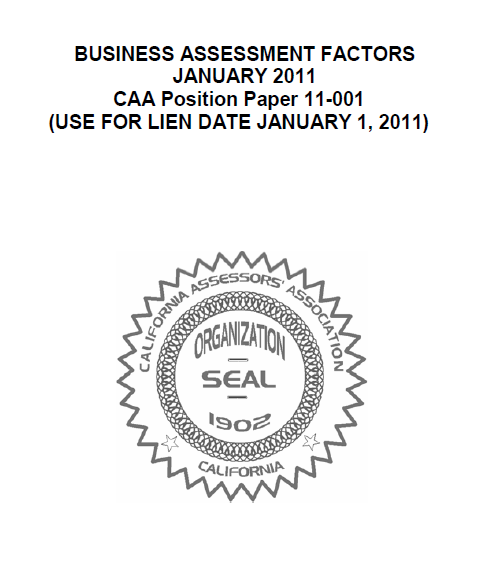
Definitions
This lesson uses several terms that you should be familiar with; below are definitions for certain terms that are used throughout this lesson.
- Average Service Life or Economic Life: a measure of the period over which certain types of equipment and fixtures are expected to be usable, with normal repairs and maintenance. It is a probable life expectancy. Note: the economic life of equipment or fixtures may be shorter than their physical life, if the cost of their continued use exceeds the benefits derived from such use, even though they are still physically capable of continued use.
- Personal Property: for California property tax purposes, all property except real property. (California Revenue and Taxation Code section 106)
- Fixture: an item of tangible property, the nature of which was originally personal property, but which is classified as real property for property tax purposes because it is physically or constructively annexed to real property with the intent that it remain so indefinitely. (Property Tax Rule 122.5)
The Concept
Average service life, or economic life, can be estimated by an appraiser based on a mortality study of individual acquisitions and retirements, historical usage of property, useful life expectancy as reflected by the applicable industry, or other information as available. (Refer to Assessors' Handbook Section 504, chapter 4, for further discussion on lives and percent good factors.)
While the measure of economic life, or average service life, can be in terms of years-of-use, hours-of-operation, units produced, et cetera, the percent good factors presented in Assessors' Handbook Section 581 Table 4, are intended to be selected according to the equipment's or fixture's economic life in terms of years of normal use. In mass appraisal situations, estimating life for each piece of equipment is not practical; therefore, service life is not generally estimated on an individual basis. This is important to keep in mind, as the typical use of Table 4 may have to be adjusted if the equipment being valued has experienced abnormal, excessive, or even less-than-expected depreciation. For example: if a piece of equipment that is expected have an economic life of 12 years, based on an eight-hours-a-day five-days-a-week normal rate of operation, is used by a business which normally operates it more than eight-hours-a-day five-days-a-week, then an adjustment of the equipment's economic life, in years, will have to be made in order to select the correct percent good factor for use in the valuation of the equipment.
For purposes of valuing personal property and fixtures in California, average service life is needed in order to select percent good factors from Table 4 of AH 581; refer to discussion in Lesson 3 for specific application. The California Assessors' Association (CAA) recommends lives that assessors should use in conjuction with the AH 581 factors. CAA publishes a position paper Business Assessment Factors annually which incorporate the factors published in the Board of Equalization's AH 581 and recommends lives for numerous categories of equipment in Section IV, Economic Life and Minimum Percent Good Table. The recommended life listing is in alphabetical order by equipment category.
The life found in the CAA publication in conjunction with the acquisition year of the equipment are used to determine the appropriate percent good factor in Table 4 of AH 581 for machinery and equipment. As discussed in Lesson 3, Table 4 is used for commercial, industrial, non-mobile construction, and non-mobile agricultural equipment.
The following information is provided to aid the appraiser in estimating the service life to use in valuing certain types of equipment utilizing the economic lives published by the CAA.
Applications of The CAA Table to Determine Economic Life (Average Service Life)
The following provides step by step demonstrations and examples of how to determine the economic life, or average service life, of various types of equipment and fixtures using CAA’s Economic Life table found in Section IV of their annual publication (position paper), Business Assessment Factors.
NOTE: Just as there is no economic life for equipment in general, there is also no economic life for fixtures in general. The CAA tables recommend economic lives by categories of equipment and fixtures (i.e., automotive repair-service, beauty salon, bank fixtures, etc.).
The economic life found in the demonstrations and examples below are used in the calculations for selecting the appropriate percent good factor in Lesson 3. The lives recommended by the CAA for the 2011 lien date are used for illustrative purposes.
Commercial Equipment
Demonstration of Determining Economic Life (Average Service Life) for Commercial Equipment
The following is a step-by-step demonstration of how to determine the economic life, or average service life, of commercial equipment using CAA's Economic Life table, found in Section IV of their annual publication (position paper), Business Assessment Factors:
What is the economic life, as of lien date 2011 (January 1), of office equipment?
- Ascertain the type of equipment for which you are determining the economic life (average service life). (As previously indicated the type for demonstrations and examples was determined in Lesson 2 and continue through Lesson 3 and Lesson 5.) Office Equipment
- Select the appropriate CAA Business Assessment Factors position paper (published annually) based on the lien date (January 1, XXXX) for which the estimate of value is sought.
Position Paper 2011-001 (lien date 2011 initially chosen for illustrative purposes only)

- Locate the economic life (average service life) of the equipment corresponding to the equipment type using the Economic Life and Minimum Percent Good Table, found in Section IV, of the previously selected CAA Business Assessment Factors position paper (2011).
Office Furniture & Equipment = 12 years
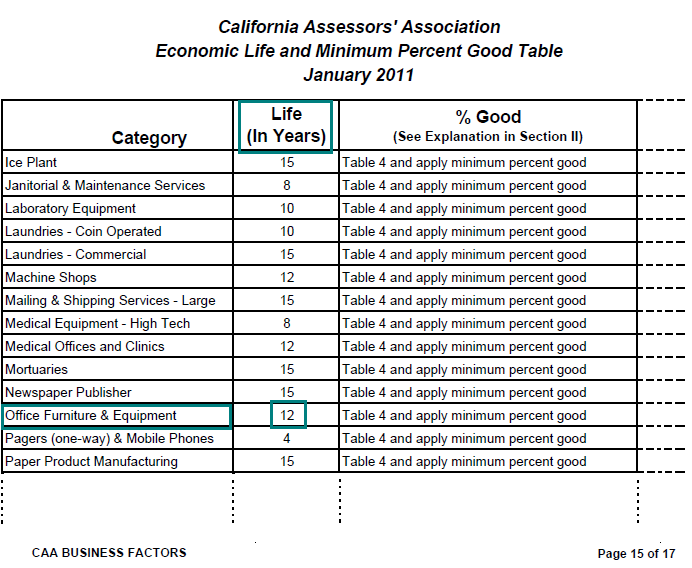
Practical Applications of Determining Economic Life for Commercial Equipment
The following examples are designed to illustrate how to determine the economic life of commercial equipment using the Economic Life and Minimum Percent Good Table, found in Section IV of the CAA position papers: Business Assessment Factors (published annually for use with lien dates). While the examples shown below use lien date 2011 for illustrative purposes, it must be remembered that it is the lien date for which values are sought that determines which yearly CAA Business Assessment Factors position paper – and associated economic lives – will be used.
Example 1:
What is the economic life, as of lien date 2011 (January 1), of restaurant equipment?
Solution:
- Economic Life (Average Service Life) = 12 years
- Locate the economic life (average service life) corresponding to the equipment type, using the Economic Life and Minimum Percent Good Table, in Section IV, of the 2011 CAA Business Assessment Factors position paper.
Restaurants – Regular [or Fast Food Chains] = 12 years
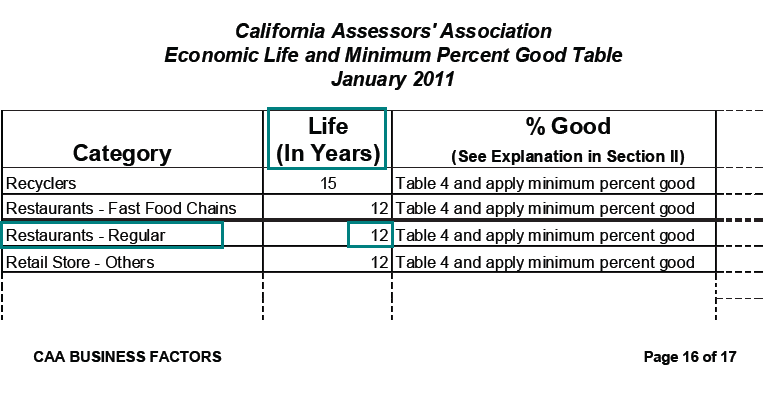
Example 2:
What is the economic life, as of lien date 2011 (January 1), of grocery store equipment?
Solution:
- Economic Life (Average Service Life) = 12 years
- Locate the economic life (average service life) corresponding to the equipment type, using the Economic Life and Minimum Percent Good Table, in Section IV, of the 2011 CAA Business Assessment Factors position paper.
Grocery Stores – Supermarkets [or Convenience] = 12 years
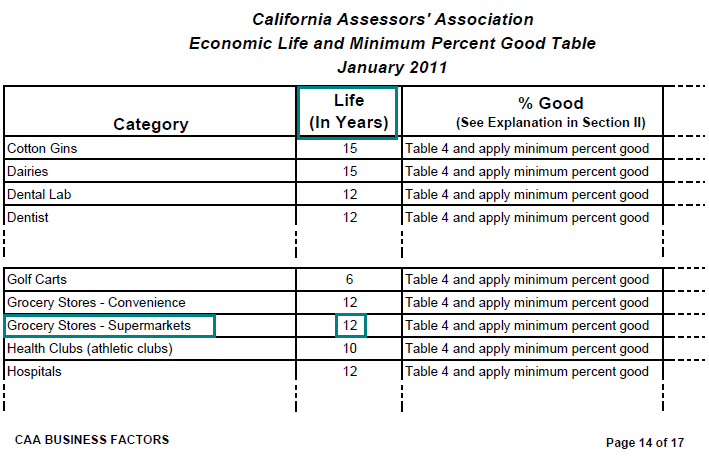
Example 3:
What is the economic life, as of lien date 2011 (January 1), of hotel room furnishings?
Solution:
- Economic Life (Average Service Life) = 8 years
- Locate the economic life (average service life) corresponding to the equipment type, using the Economic Life and Minimum Percent Good Table, in Section IV, of the 2011 CAA Business Assessment Factors position paper.
Hotels & Motels (Furnishings) = 8 years
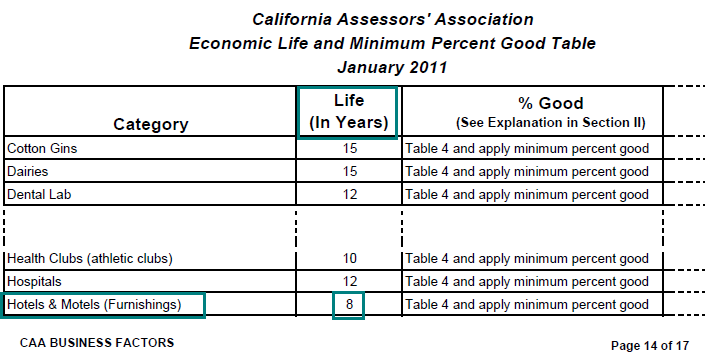
Industrial Equipment
Demonstration of Determining Economic Life (Average Service Life) for Industrial Equipment
The following is a step-by-step demonstration of how to determine the economic life, or average service life, of industrial equipment using CAA's Economic Life table, found in Section IV of their annual publication (position paper), Business Assessment Factors:
What is the economic life, as of lien date 2011 (January 1), of cement manufacturing equipment?
- Ascertain the type of equipment for which you are determining the economic life (average service life). (As previously indicated the type for demonstrations and examples was determined in Lesson 2 and continue through Lesson 3 and Lesson 5.) Cement Manufacturing Equipment
- Select the appropriate CAA Business Assessment Factors position paper (published annually) based on the lien date (January 1, XXXX) for which the estimate of value is sought.
Position Paper 2011-001 (lien date 2011 initially chosen for illustrative purposes only)

- Locate the economic life (average service life) of the equipment corresponding to the equipment type using the Economic Life and Minimum Percent Good Table, found in Section IV, of the previously selected CAA Business Assessment Factors position paper (2011).
Cement Manufacturing = 30 years
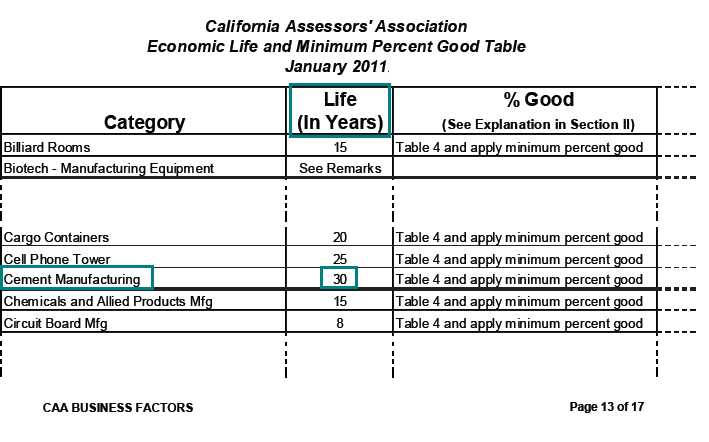
Practical Applications of Determining Economic Life for Industrial Equipment
The following examples are designed to illustrate how to determine the economic life of industrial equipment using the Economic Life and Minimum Percent Good Table, found in Section IV of the CAA position papers: Business Assessment Factors (published annually for use with lien dates). While the examples shown below use lien date 2011 for illustrative purposes, it must be remembered that it is the lien date for which values are sought that determines which yearly CAA Business Assessment Factors position paper – and associated economic lives – will be used.
Example 1:
What is the economic life, as of lien date 2011 (January 1), of food processing equipment?
Solution:
- Economic Life (Average Service Life) = 15 years
- Locate the economic life (average service life) corresponding to the equipment type, using the Economic Life and Minimum Percent Good Table, in Section IV, of the 2011 CAA Business Assessment Factors position paper.
Food Processing = 15 years
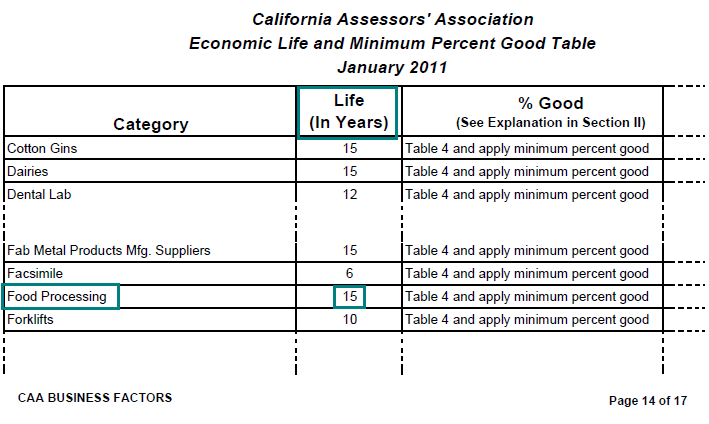
Example 2:
What is the economic life, as of lien date 2011 (January 1), of apparel (clothing) manufacturing equipment?
Solution:
- Economic Life (Average Service Life) = 12 years
- Locate the economic life (average service life) corresponding to the equipment type, using the Economic Life and Minimum Percent Good Table, in Section IV, of the 2011 CAA Business Assessment Factors position paper.
Apparel Manufacturing = 12 years
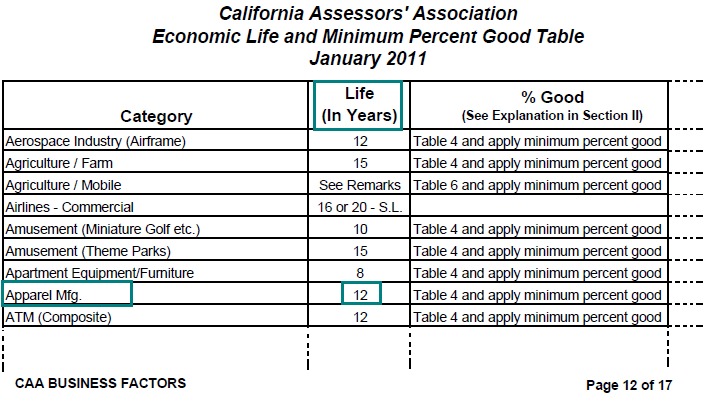
Example 3:
What is the economic life, as of lien date 2011 (January 1), of circuit board manufacturing equipment?
Solution:
- Economic Life (Average Service Life) = 8 years
- Locate the economic life (average service life) corresponding to the equipment type, using the Economic Life and Minimum Percent Good Table, in Section IV, of the 2011 CAA Business Assessment Factors position paper.
Circuit Board Manufacturing = 8 years
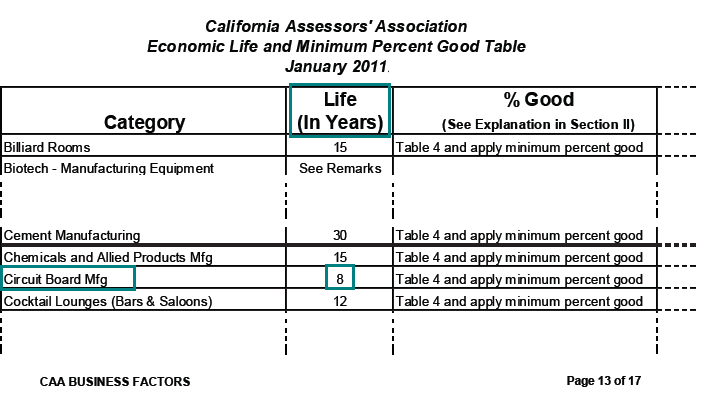
Non-Mobile Construction Equipment
Demonstration of Determining Economic Life (Average Service Life) for Non-Mobile Construction Equipment
The following is a step-by-step demonstration of how to determine the economic life, or average service life, of non-mobile construction equipment using CAA’s Economic Life table, found in Section IV of their annual publication (position paper), Business Assessment Factors:
What is the economic life, as of lien date 2011 (January 1), of a light plant (non-mobile construction equipment)?
- Ascertain the type of equipment for which you are determining the economic life (average service life). (As previously indicated the type for demonstrations and examples was determined in Lesson 2 and continue through Lesson 3 and Lesson 5.) Light Plant (non-mobile construction equipment)
- Select the appropriate CAA Business Assessment Factors position paper (published annually) based on the lien date (January 1, XXXX) for which the estimate of value is sought.
Position Paper 2011-001 (lien date 2011 initially chosen for illustrative purposes only)

- Locate the economic life (average service life) of the equipment corresponding to the equipment type using the Economic Life and Minimum Percent Good Table, found in Section IV, of the previously selected CAA Business Assessment Factors position paper (2011).
Construction / Demolition Contractor = 12 years
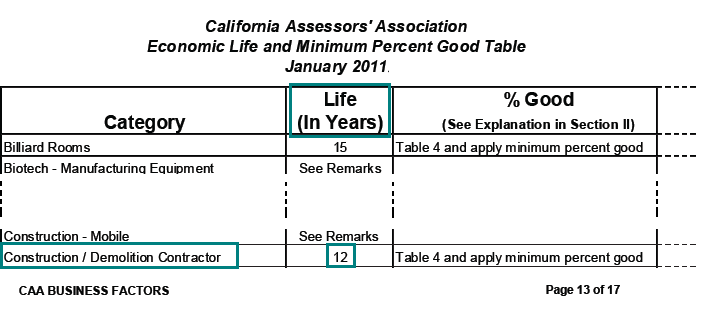
Practical Application of Determining Economic Life for Non-Mobile Construction Equipment
The following examples are designed to illustrate how to determine the economic life of non-mobile construction equipment using the Economic Life and Minimum Percent Good Table, found in Section IV of the CAA position papers: Business Assessment Factors (published annually for use with lien dates). While the example shown below uses lien date 2011 for illustrative purposes, it must be remembered that it is the lien date for which values are sought that determines which yearly CAA Business Assessment Factors position paper – and associated economic lives – will be used.
Example 1:
What is the economic life, as of lien date 2011 (January 1), of a large volume pump (non-mobile construction contractor equipment)?
Solution:
- Economic Life (Average Service Life) = 12 years
- Locate the economic life (average service life) corresponding to the equipment type, using the Economic Life and Minimum Percent Good Table, in Section IV, of the 2011 CAA Business Assessment Factors position paper.
Construction / Demolition Contractor = 12 years

Non-Mobile Agricultural Equipment
Demonstration of Determining Economic Life (Average Service Life) for Non-Mobile Agricultural Equipment
The following is a step-by-step demonstration of how to determine the economic life, or average service life, of non-mobile agricultural equipment using CAA's Economic Life table, found in Section IV of their annual publication (position paper), Business Assessment Factors:
What is the economic life, as of lien date 2011 (January 1), of a cotton gin (non-mobile agricultural equipment)?
- Ascertain the type of equipment for which you are determining the economic life (average service life). (As previously indicated the type for demonstrations and examples was determined in Lesson 2 and continue through Lesson 3 and Lesson 5.) Cotton Gin (non-mobile agricultural equipment)
- Select the appropriate CAA Business Assessment Factors position paper (published annually) based on the lien date (January 1, XXXX) for which the estimate of value is sought.
Position Paper 2011-001 (lien date 2011 initially chosen for illustrative purposes only)

- Locate the economic life (average service life) of the equipment corresponding to the equipment type using the Economic Life and Minimum Percent Good Table, found in Section IV, of the previously selected CAA Business Assessment Factors position paper (2011).
Cotton Gins = 15 years
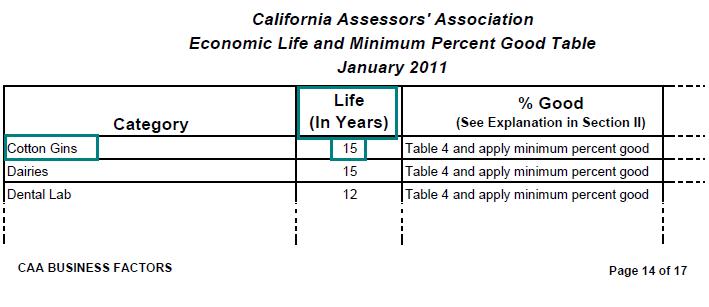
Practical Application of Determining Economic Life for Non-Mobile Agricultural Equipment
The following examples are designed to illustrate how to determine the economic life of non-mobile agricultural equipment using the Economic Life and Minimum Percent Good Table, found in Section IV of the CAA position papers: Business Assessment Factors (published annually for use with lien dates). While the example shown below uses lien date 2011 for illustrative purposes, it must be remembered that it is the lien date for which values are sought that determines which yearly CAA Business Assessment Factors position paper – and associated economic lives – will be used.
Example 1:
What is the economic life, as of lien date 2011 (January 1), of dairy equipment (non-mobile agricultural equipment)?
Solution:
- Economic Life (Average Service Life) = 15 years
- Locate the economic life (average service life) corresponding to the equipment type, using the Economic Life and Minimum Percent Good Table, in Section IV, of the 2011 CAA Business Assessment Factors position paper.
Dairies = 15 years
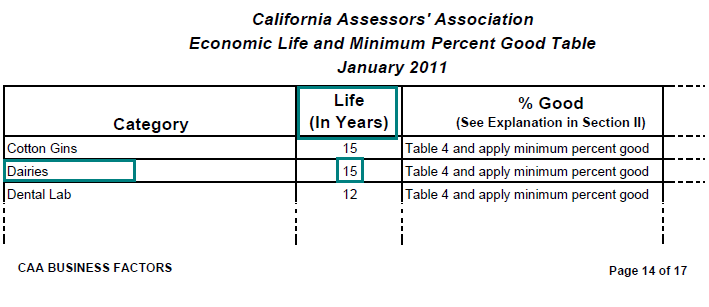
Lesson Summary
The lesson you just read on determining the economic life, or average service life, of equipment and fixtures demonstrates how to arrive at such a life, which is very often a necessary step in valuing personal property and fixtures. In Lesson 3, you learned that where the type of equipment or fixture being valued uses factors found in AH 581 Table 4: Machinery and Equipment Percent Good Factors, selection of the applicable percent good factor is based on the acquisition year and economic (average service) life of the equipment or fixture. In this lesson you learned about the source of lives published and recommended by the California Assessors' Association, for use by California county assessors in their mass appraisal of personal property and fixtures.
Note: Before proceeding on to the next lesson, be sure to complete the exercises for this lesson.

